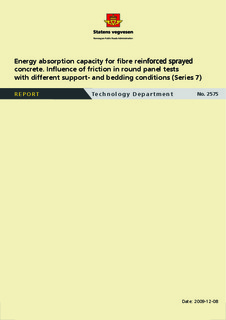| dc.description.abstract | The test program is part of the on-going revision of The Norwegian Associations publication no. 7 (Sprayed concrete for
rock support), which among others is to be harmonized with the new European regulations for determination of energy
absorption capacity of fiber reinforced sprayed concrete. The present test program involves round panels and is a study on
different support- and bedding conditions and their effect on friction in panel tests.
A new modified support ring of steel was made specifically for the present tests. The motive was to give the support a
more optimal design as a separate measure to reduce friction between the panel and the support. The tests make use of
two support rings, the new modified steel support ring and, for comparison, the traditional wooden support ring.
Totally five different support/bedding conditions were tested on 600 mm round, nominally identical, panels. The displacement
rate in the tests was 3 mm/min.
Among the four individual test sets consisting of three or four panels the results show that the average coefficient of variation
for the energy uptake between zero and 25 mm displacement was 8.8%.
The variable support- and bedding conditions had a great influence on the apparent energy uptake from the panel test.
The overall energy uptake from the tests with wooden support confirms earlier results in the way that the accumulated
friction effect is very high (here: 42% friction). The friction from the steel support was a bit lower, but still substantial
(35%). Bedding of one layer of Teflon on steel support reduced the friction effect (18%) and bedding with two layers
reduced it further (6%), but the latter result is uncertain as this set contains only one panel due to some logging error.
Bedding of two PVC-membranes+grease is used as reference - it is assumed that there is no friction for this support condition.
Increasing friction appears to represent a reinforcing effect which generates a local strain-hardening behaviour in the
panel around the contact-zone with the support. This is seen as local multiple cracking in this zone.
The Teflon suffered significant wearing during testing and had to be renewed in each test. A drawback with Teflon is that
it makes the testing procedure more cumbersome as it gives extra work during the preparation of each test; more work
naturally for two layers than for one layer. The bedding with PVC-membranes+grease has shown very effective to
reduce/eliminate friction and is a good reference, but it is very laborious and can hardly be used in a standard procedure.
The trend is that friction also influences the maximum load during the test as well as the residual load at the end of the
test; the effect is most evident for the latter.
The new rounded steel support did not give lower friction than earlier tests that used a steel support with a sharp inner
edge. | nb_NO |
